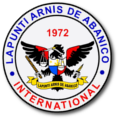With Master Edgar Caburnay
I arrived at the gym of Master Edgar Caburnay in Balamban, Cebu at around 10am on the 15th of October, a Saturday. His morning martial arts class was rescheduled on the afternoon so I got the rest of Master Edgar’s morning for myself. Our discussions started with the approach and methodology he employs in teaching Lapunti. Later in the day, our discussion will end with his future plans and visions for the association. Master Edgar has a very animated way of driving his points.
I summarized my day’s learnings into three points: (1) Conditioning is essential to training, (2) Progression in/from techniques grounds the practitioner in the very foundation of the art, and (3) Repetition and drilling is the key to mastery.
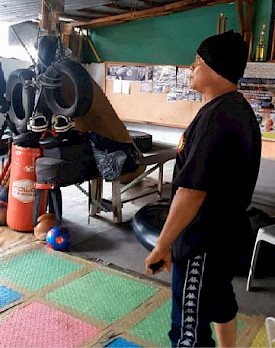
Master Edgar’s classes are started with calisthenics and conditioning exercises. A cardboard displayed in one section of the his gym lists these exercises (just reading through the list gives me a body ache and my mind is discouraging me from attempting a start). He has several variants of push ups, sit ups, and leg splits in the list. He explained that he adapted these conditioning exercises from Yaw-Yan, the Filipino Kick Boxing art which he also teaches. A martial artist’s body, according to Master Edgar, should be very well conditioned for fighting. A conditioned body moves faster, hits harder, and can absorb more punishment.
I noticed a pair of wooden dummies in the gym. These were not there the last time I visited last February. The dummies resemble the Wing Chun wooden man post (Mu ren zhuang) including the extended limb that is supposed to represent the forward leg. According to Master Edgar, the dummies are primarily used to condition the arms and to practice the left hand (“the alive hand”) during strikes. I tried using one of the dummies by striking my forearms against the arms of the dummy, ala Ip Man. Through the pain brought about by the violent clash of flesh and bones against hard wood, I quickly realize that this would definitely condition one’s arms, if it would not get fractured first :).
Master Edgar then asked me to demonstrate to him the Lapunti curriculum we use at the UP Diliman training group. I started to do a run down of the curriculum in the Likas and Luntian levels. According to Master Edgar, generally, our curriculum are the same except that he introduced additional drills and forms at various stages of the student’s progress. Also, he observed that there were some minor differences in how we do the forms.
Master Edgar mentioned that he made variations on the common forms and drills and he intended it for the student who has already mastered the regular form. For example, in the Classical Form No 1, he added additional striking combinations after the regular high abaniko strike. After students have mastered the regular Classical Form No 1, he will teach the advanced version of the form and ask students to master it first before proceeding to the next set of lessons.
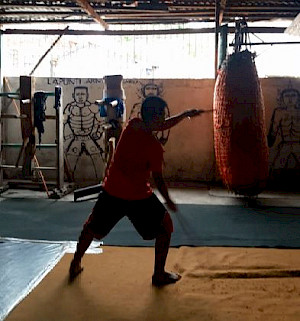
After a quick lunch, Master Edgar then called on his eldest son to perform the Lapunti curriculum as practiced in his gym. From all indications that I can see, the eldest son will eventually be in the same level as his father. The beginnings of a quick, fluid, and strong arnisador is in the boy’s movements. He started to do the cross legging exercises, first without strikes, then with single strikes, then with multiple strikes. Footwork drills succeeded the cross legging exercises, incorporating strikes in progressing degrees of complexity.
After which, the young protegee started performing the various forms. I had my first hand view of the Intermediate Forms that Master Edgar incorporated. I noticed the elaborate footwork and swinging and flowing strikes in these forms. Also, there were mat rolling sequences in the more advanced forms, simulating an escape from a difficult position. What surprised me the most in the demonstration of the forms was that the 3rd intermediate form was an espada y daga form. I commented on this peculiarity as the espada y daga is normally taught at the Lakan level. Master Edgar mentioned that he thinks the espada y daga should be introduced early on to emphasize to the practitioner the difference in handling the main weapon (the stick or sword) when another weapon is in the other hand (the knife).
Master Edgar then proceeded to explain the primary purpose of the additional strikes, forms, and drills he introduced: that is, to ground the practitioner on a very strong Lapunti foundation. He lamented that he always see Lapunti practitioners that were obviously not grounded or drilled enough to do Lapunti strikes and combinations properly. This, he says, is the result of just going through the curriculum of the level and quickly moving from one drill or form to another – without the hours and hours of repetition and drilling.
We did not notice the time and how it quickly passed. Soon enough, those attending Master Edgar’s class started to arrive. We rested and during the break Master Edgar started narrating anecdotes about his instructor’s in the different martial arts in past. They were a colorful bunch and are stuff made of legend. Our discussions eventually led to an agreement that the history of Lapunti, its originators, masters, and practitioners, from the first generation up to their current generation should be written down in a book for posterity’s sake.
I left Master Edgar’s gym around 3pm as I need to secure the reservation in my hotel, lest the hotel gives my slot to another. We continued to deliberate on the various issues and concerns in the Lapunti association as we walked towards the public transport stop in the highway. Clearly, much has been done, but much, much more needs to be accomplished. Soon the van for hire that will take me back to Cebu City proper arrived. We quickly parted with promises to keep in touch.
With Master Basilio Igpit Jr.
I walked from my hotel along Osmeña Blvd, Cebu City, to downtown Cebu, passing by the famous Sto Niño church. The less than 2km walk was not that arduous as the weather was quite cool. My destination was the plaza in front of Fort San Pedro to train in the regular training sessions conducted by Master Basilio “Jun” Igpit Jr. I arrived at around 8am on the Sunday of my trip, October 16. I made a mental note that the next time I visit Cebu, I have to wear my tourist hat and go inside Fort San Pedro.
I noticed that in the plaza throngs of high school and college students were practicing Arnis forms or anyo, most likely as part of their school’s requirement. I tried to analyze what their Arnis styles were based on their movements, footwork, and strikes. Clearly, they were not practicing Lapunti as they do not have the distinct combinations and footwork that highlights Lapunti practitioners. My guess was they were doing a style of “San Miguel” based on the double downward circular strike that I noticed (similar to Lapunti’s long reach strike). Later on, Master Jun will tell me that they are most likely practicing a “Doce Pares” style.
Master Jun arrived with his son and daughter a few minutes later. All in the black Lapunti uniforms. Master Jun informed me that he would be in Manila soon to prepare for the visa requirements for his trip to Luxembourg. There would be a World Eskrima-Kali-Arnis Federation (WEKAF) qualification tournament in Luxembourg and Master Jun will be advising the Luxembourg team on the rules of WEKAF. Master Jun is a certified referee for WEKAF tournaments. Interesting to note is that the team from Luxembourg preparing for the WEFAK tournament next year are mostly Lapunti practitioners.
We started our training session with calisthenics and wrist strengthening exercises. It was a surprise for me to learn that Master Jun employs double sticks during this part of the training. I inquired why the doble baston is used early on when it is normally taught at the advanced Lakan levels. Master Jun explained that in the Lapunti curriculum, stick snatching is taught at the basic level. He observed that most of the beginning Lapunti practitioners would not know what to do once they snatched the opponent’s stick. Jokingly, he said that he observed most practitioners would just throw away the stick they just snatched since they would not know what to do with two sticks in hand. This he says is dangerous as the stick maybe picked up by allies of the disarmed opponent when thrown after a successful snatch.
We proceeded with the doble baston drills that incorporates footwork and cross legging. The doble baston drill has more upward strikes (strikes #6 and #7 of the Lapunti Strikes) than the more common downward strikes. Master Jun noted that this drill emphasize the upward strikes of Lapunti as these are not very common in the major forms of Lapunti. Master Jun proceeded to demonstrate against me the use of these upward strikes to defend against downward strikes from doble baston. I ended up with both of my hands tied and locked like pretzels.
After our doble baston drills, we reviewed the various main forms of Lapunti: the Attack and Retreat, the Counter Strike, and the Arco. Some of the forms have variations on how it is practiced in UP Diliman. As I found the variations seemingly unnatural, Master Jun demonstrated the application of these variants in fighting situations. What followed were “aaahhs” and “eureka” moments.
What strikes me in how we go through the forms was the breaking down of Master Jun of the forms into smaller sequences which are then drilled repeatedly. This method of teaching the forms helps much in form memorization and muscle memory. Soon the practitioner would be carrying out the form without even thinking about the next steps. Rapid and powerful execution can then easily follow.
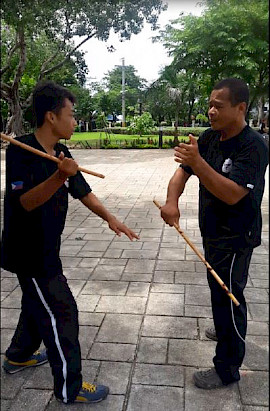
Master Jun and his eldest son then proceeded to demonstrate intermediate Lapunti disarms from the Tapi-Tapi. This is facilitated by transitioning, directing, and maneuvering the partner’s stick from one side of one’s body to the other. Even the simulation of the #5 common strike stab to the lower abdomen is simulated effortlessly through the principle of transitioning and maneuvering from the Tapi-Tapi. Master Jun explained that if these disarms are practiced and mastered from the Tapi-tapi then quick reflexes can be developed.
At this point, I observed that there were many spectators crowding around to watch us practice. Some were even taking cellphone videos. Some of the students practicing for their school’s Arnis activity started mimicking the techniques that they see us doing. Eventually two spectator came forward and inquired from Master Jun about lessons. Assisted by his son, Master Jun gave them the beginner’s first lessons and during their breaks he drilled me with Tapi-tapi techniques.
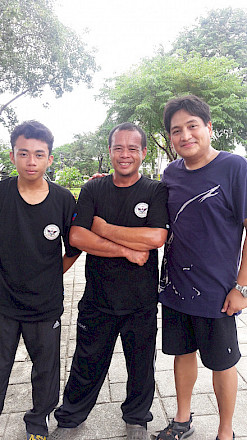
It was interesting to see how Master Jun handled the beginner’s sessions. To keep the students interested and see progress in themselves, he early on introduced footwork, cross legs, and some Lapunti strikes. In contrast, we usually start off new students with the 12 common strikes. The effect of this early introduction is that students can appreciate the fighting aspect of the art early on. I noticed that the students were having difficulties with the cross leg maneuver. Master Jun paused the class and discussed the importance and practicality of the cross leg maneuver in Bisaya. Eventhough I know very few Bisaya words, I was able to comprehend what he was saying based on the demonstration he is doing. I can see from the students’ reactions their appreciation of the cross leg technique. When the class resumed, I noticed that the students were exerting more effort to learn cross legging.
It was approaching 11:30am when I decided that I must take my leave. Originally, I planned to leave at around 11am as I have to checkout of my hotel by 12pm. I was told by one of the new student of Master Jun about the news that Cebu Pacific flights in the morning to Manila have been canceled because of typhoon Karen. I crossed my finger hoping that afternoon flights would not be canceled. I bade my goodbyes to Master Jun and his kids and indicated my hope in seeing him in Manila in the coming days.
